|

Part
1 - from
1454 to 1510
Part
2 - from
1512 to 1577
Part
3 - from
1577 to 1618
Part
4 - from
1618 to 1647
Part
5 - from
1648 to 1655
Part
6 - from 1655 to 1660
Part
7 - from
1660 to 1672
Part
8 - from
1672 to 1699
|
|
1672-1699
(links to map of Poland)
The
Turkish and Tartar Wars
1667-1676 (Continued)
 In
August 1672 the Turks entered the conflict proper. An army of 80,000
crossed the Dniestr and besieged Kamieniec Podolski, which although
it was an old fort with a small garrison it was in a naturally powerful
defensive position quite capable of withstanding a long siege. The
weak commander, however capitulated after only seven days. The Turks
devastated Pokucie and moved on towards Lvov, which was poorly defended.
In the Sejm King Michael was having problems with the nobles and
no new forces were forthcoming. All the king could do was send commissars
to sue for peace with the Sultan. In
August 1672 the Turks entered the conflict proper. An army of 80,000
crossed the Dniestr and besieged Kamieniec Podolski, which although
it was an old fort with a small garrison it was in a naturally powerful
defensive position quite capable of withstanding a long siege. The
weak commander, however capitulated after only seven days. The Turks
devastated Pokucie and moved on towards Lvov, which was poorly defended.
In the Sejm King Michael was having problems with the nobles and
no new forces were forthcoming. All the king could do was send commissars
to sue for peace with the Sultan.
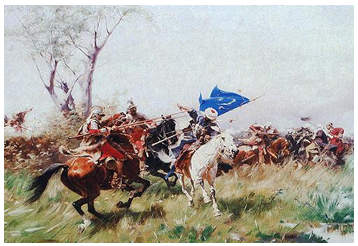 On
the 26th of August the Tartars reached Lvov. Sobieski too weak to
aid Lvov began his famous 'raid on the czambuls'
(Tartar army). With 2,500-3,000 cavalry and dragoons he traveled
some 450 Km in nine days (5-14 October 1672), and with the help
of local peasants defeated two large and a number of smaller tartar
forces, totaling some 20,000 men, and releasing 44,000 prisoners!
His aim had been to reduce the Tartar ravaging and improve Poland's
bargaining position in the peace talks. Although it was a brilliant
success it could not make up for losses elsewhere and did not effect
the shameful Buczacz agreement, which gave up a large slice of the
Ukraine to Turkey and required Poland to pay a tribute. Only now
did the nobles realise the seriousness of the situation. On
the 26th of August the Tartars reached Lvov. Sobieski too weak to
aid Lvov began his famous 'raid on the czambuls'
(Tartar army). With 2,500-3,000 cavalry and dragoons he traveled
some 450 Km in nine days (5-14 October 1672), and with the help
of local peasants defeated two large and a number of smaller tartar
forces, totaling some 20,000 men, and releasing 44,000 prisoners!
His aim had been to reduce the Tartar ravaging and improve Poland's
bargaining position in the peace talks. Although it was a brilliant
success it could not make up for losses elsewhere and did not effect
the shameful Buczacz agreement, which gave up a large slice of the
Ukraine to Turkey and required Poland to pay a tribute. Only now
did the nobles realise the seriousness of the situation.
This treaty,
at last, awoke the nobles of the Sejm who would not ratify the treaty
and agreed to a massive expansion of the army. The actual forces
were fewer than proposed but resulted in 37,250 troops with 65 cannons.
In
Lvov on the 11th November 1673 the King died.
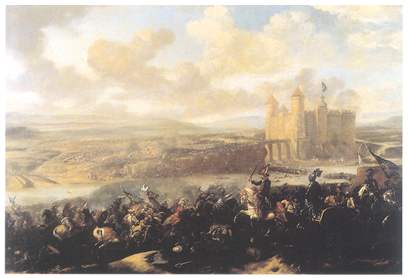 In
1673 the Turks prepared to defend their gains leaving three main
forces 30,000 men at Chocim, 10,000 at Kamieniec Podolski and 15,000
at Jassam (capital of Moldavia). Sobieski decided to destroy the
largest force, slicing through their communication lines and the
turning on Chocim. The Turks held the Chocim castle which had been
strengthened since the Poles and Cossacks successfully defended
it against the Turks in 1621. Sobieski with 30,000 men attacked
on arrival but failed to break in, his forces then waited throughout
the bitterly cold night forcing the enemy to stay at the ready.
As dawn broke the Poles attacked, surprising the Turks, and with
close artillery support the dragoons and infantry forced their way
into Chocim
castle. They then cleared a way through the debris for the cavalry,
who burst into the Turkish camp. The victory was decisive and complete.
In an attempt to capitalise on this victory Sobieski invaded Moldavia
and the Turks at Jassam retreated as the Poles approached. However
Sobieski was seriously hampered by the Lithuanian Hetman Pac, who
soon left to return home with his forces, while distance from home
and low pay dramatically increased desertions. In
1673 the Turks prepared to defend their gains leaving three main
forces 30,000 men at Chocim, 10,000 at Kamieniec Podolski and 15,000
at Jassam (capital of Moldavia). Sobieski decided to destroy the
largest force, slicing through their communication lines and the
turning on Chocim. The Turks held the Chocim castle which had been
strengthened since the Poles and Cossacks successfully defended
it against the Turks in 1621. Sobieski with 30,000 men attacked
on arrival but failed to break in, his forces then waited throughout
the bitterly cold night forcing the enemy to stay at the ready.
As dawn broke the Poles attacked, surprising the Turks, and with
close artillery support the dragoons and infantry forced their way
into Chocim
castle. They then cleared a way through the debris for the cavalry,
who burst into the Turkish camp. The victory was decisive and complete.
In an attempt to capitalise on this victory Sobieski invaded Moldavia
and the Turks at Jassam retreated as the Poles approached. However
Sobieski was seriously hampered by the Lithuanian Hetman Pac, who
soon left to return home with his forces, while distance from home
and low pay dramatically increased desertions.
On news of
the King's death Sobieski returned to Poland leaving garrisons in
the major strongholds. In January 1674 new Turkish forces evicted
the Poles from Moldavia and also broke the blockade on Kamieniec
Podolski, which was close to capitulation.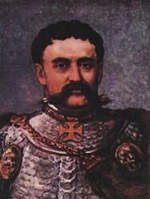
The
victorious Hetman Jan Sobieski
was elected King on 19th May 1674.
So began the reign of the
' scourge of the Tartars'.
In mid 1674
the Turks directed their main attack towards the Muscovite army
in the Ukraine. Jan III Sobieski decided
to take advantage of the situation and attack the enemy in the rear.
Unfortunately an early attack by part of his forces warned the Turks
who made a hasty retreat. In October Polish forces aided by the
local Ukrainian population recaptured all of the Ukrainian strongholds,
except for the well defended fortress of Kamieniec Podolski.
In 1675 a
200,000 strong Turkish army crossed the Dniestr and captured a series
of strongholds. The Poles were mobilising slowly at Lvov and Sobieski
repeated his tactics of 1667 in order to gain valuable time. In
mid August the Turks reached Zborow and the Turkish commander, realising
Sobieski's problem sent a 20,000 strong czambul
to disrupt the Poles. At the Battle of Lvov
(24 August 1675) Sobieski, with 5,000, crushed the Tartars and destroyed
them in a vigorous pursuit. With the advance of the concentrated
Polish army (32,000), the Turkish army turned back from its advance
on Lvov destroying Pomarzan and Podhajce on the way. At Trembowl
(defended by Jan Samuel Chrzanowski with 80 dragoons and 200 townsmen)
the Turkish attacks were repulsed inflicting on them heavy losses
and when Sobieski approached and threatened their rear the Turks
retreated.
Sobieski
planned to bring the war to a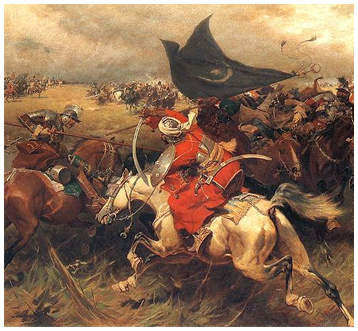 decisive end in 1676, but the large army he forced through the Sejm
could not be raised, due to the lack of funds. The Turks invaded
again, but were held back at the fortified camp at Zurawno
(25 September to 14 October 1676). After three weeks of attacks
the Turks (16,000 with 77 canon) and Tartars (30,000) gave up and
agreed to a truce. While only a fraction of the 8,000 Polish forces
had been involved in the fighting. The truce ended the long war
and although Turkey retained a substantial part of the Ukraine large
numbers of Polish prisoners were released.
decisive end in 1676, but the large army he forced through the Sejm
could not be raised, due to the lack of funds. The Turks invaded
again, but were held back at the fortified camp at Zurawno
(25 September to 14 October 1676). After three weeks of attacks
the Turks (16,000 with 77 canon) and Tartars (30,000) gave up and
agreed to a truce. While only a fraction of the 8,000 Polish forces
had been involved in the fighting. The truce ended the long war
and although Turkey retained a substantial part of the Ukraine large
numbers of Polish prisoners were released.
1683 Campaign
The war in 1683 was a coalition of Christian countries, with Poland
allied to the Emperor and the Papacy. Turkey was close to capturing
Vienna as the Poles approached. Sobieski was given command of the
allied army (29,500 Austrians, 18,000 Imperialists and 27,000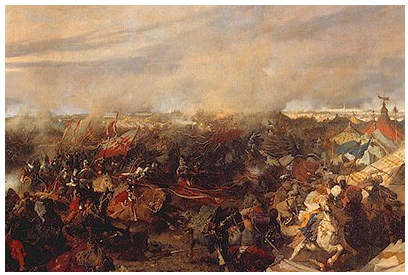 Poles) and his plan was to hem in the Ottoman army and pin it against
the Danube and Vienna's walls. He did not only want to defeat the
Turks, because this would bring little advantage to Poland, but
he aimed at destroying them. Sobieski divided the army into three
columns several days before the battle, as it sped towards Vienna
to catch the Turks unawares. The left column moved along a road
next to the Danube, while the other two columns' approach was slower
along the mountain roads. As the left and centre columns tied up
the main Turkish forces in battle, the mainly Polish cavalry right
column charged onto the Turks aiming to cut off their escape. The
battle of Vienna's
(12 September 1683) result did not meet Sobieski's aim, as due to
the large size of the allied army and the difficult terrain, the
right column could not get enough distance between itself and the
main body of the army and the enemy perceived the manoeuvre, though
their only defence against the encirclement lay in retreat which
soon turned to rout. The victory made the allies overconfident and
Sobieski was caught in an attack on the Polish advance guard at
Parkany.
Poles) and his plan was to hem in the Ottoman army and pin it against
the Danube and Vienna's walls. He did not only want to defeat the
Turks, because this would bring little advantage to Poland, but
he aimed at destroying them. Sobieski divided the army into three
columns several days before the battle, as it sped towards Vienna
to catch the Turks unawares. The left column moved along a road
next to the Danube, while the other two columns' approach was slower
along the mountain roads. As the left and centre columns tied up
the main Turkish forces in battle, the mainly Polish cavalry right
column charged onto the Turks aiming to cut off their escape. The
battle of Vienna's
(12 September 1683) result did not meet Sobieski's aim, as due to
the large size of the allied army and the difficult terrain, the
right column could not get enough distance between itself and the
main body of the army and the enemy perceived the manoeuvre, though
their only defence against the encirclement lay in retreat which
soon turned to rout. The victory made the allies overconfident and
Sobieski was caught in an attack on the Polish advance guard at
Parkany. 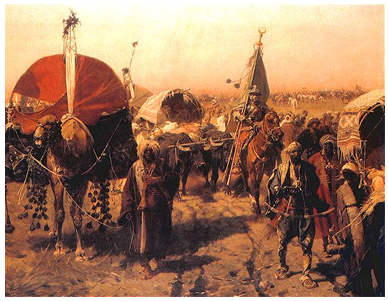 It
was a shameful defeat since the attack succeeded as far as the Polish
infantry and German cavalry, breaking through even the hussars,
and Sobieski was almost killed. However two days later the triumphant
Turks fought the second battle of Parkany
(9 October 1683) with a river to their rear. The allies crushed
them and Sobieski felt that this victory was greater than that at
Vienna. It
was a shameful defeat since the attack succeeded as far as the Polish
infantry and German cavalry, breaking through even the hussars,
and Sobieski was almost killed. However two days later the triumphant
Turks fought the second battle of Parkany
(9 October 1683) with a river to their rear. The allies crushed
them and Sobieski felt that this victory was greater than that at
Vienna.
1686
Moldavian Campaign
In July 1686 Sobieski set out with a force of 40,000 to Moldavia,
on the 16 August he reached Jassam, but the Turks avoided battle
and provisions and water was scarce. When in the capital a large
quantity of munitions caught fire and much of the city was burned,
the Poles had no other choice but to return.
1691
Moldavian Campaign
In 1691 a second Moldavian campaign was undertaken, though it was
similar to the first with an evasive enemy and arid weather. There
were some modest gains, but Sobieski succumbed to an illness a 'germ
of death' which he could not recuperate from.
On 17 June 1696 Jan III Sobieski
died.
 8 8
|
|


Page 8
|

![]()
 In
August 1672 the Turks entered the conflict proper. An army of 80,000
crossed the Dniestr and besieged Kamieniec Podolski, which although
it was an old fort with a small garrison it was in a naturally powerful
defensive position quite capable of withstanding a long siege. The
weak commander, however capitulated after only seven days. The Turks
devastated Pokucie and moved on towards Lvov, which was poorly defended.
In the Sejm King Michael was having problems with the nobles and
no new forces were forthcoming. All the king could do was send commissars
to sue for peace with the Sultan.
In
August 1672 the Turks entered the conflict proper. An army of 80,000
crossed the Dniestr and besieged Kamieniec Podolski, which although
it was an old fort with a small garrison it was in a naturally powerful
defensive position quite capable of withstanding a long siege. The
weak commander, however capitulated after only seven days. The Turks
devastated Pokucie and moved on towards Lvov, which was poorly defended.
In the Sejm King Michael was having problems with the nobles and
no new forces were forthcoming. All the king could do was send commissars
to sue for peace with the Sultan.  In
1673 the Turks prepared to defend their gains leaving three main
forces 30,000 men at Chocim, 10,000 at Kamieniec Podolski and 15,000
at Jassam (capital of Moldavia). Sobieski decided to destroy the
largest force, slicing through their communication lines and the
turning on Chocim. The Turks held the Chocim castle which had been
strengthened since the Poles and Cossacks successfully defended
it against the Turks in 1621. Sobieski with 30,000 men attacked
on arrival but failed to break in, his forces then waited throughout
the bitterly cold night forcing the enemy to stay at the ready.
As dawn broke the Poles attacked, surprising the Turks, and with
close artillery support the dragoons and infantry forced their way
into
In
1673 the Turks prepared to defend their gains leaving three main
forces 30,000 men at Chocim, 10,000 at Kamieniec Podolski and 15,000
at Jassam (capital of Moldavia). Sobieski decided to destroy the
largest force, slicing through their communication lines and the
turning on Chocim. The Turks held the Chocim castle which had been
strengthened since the Poles and Cossacks successfully defended
it against the Turks in 1621. Sobieski with 30,000 men attacked
on arrival but failed to break in, his forces then waited throughout
the bitterly cold night forcing the enemy to stay at the ready.
As dawn broke the Poles attacked, surprising the Turks, and with
close artillery support the dragoons and infantry forced their way
into 
 Poles) and his plan was to hem in the Ottoman army and pin it against
the Danube and Vienna's walls. He did not only want to defeat the
Turks, because this would bring little advantage to Poland, but
he aimed at destroying them. Sobieski divided the army into three
columns several days before the battle, as it sped towards Vienna
to catch the Turks unawares. The left column moved along a road
next to the Danube, while the other two columns' approach was slower
along the mountain roads. As the left and centre columns tied up
the main Turkish forces in battle, the mainly Polish cavalry right
column charged onto the Turks aiming to cut off their escape. The
battle of
Poles) and his plan was to hem in the Ottoman army and pin it against
the Danube and Vienna's walls. He did not only want to defeat the
Turks, because this would bring little advantage to Poland, but
he aimed at destroying them. Sobieski divided the army into three
columns several days before the battle, as it sped towards Vienna
to catch the Turks unawares. The left column moved along a road
next to the Danube, while the other two columns' approach was slower
along the mountain roads. As the left and centre columns tied up
the main Turkish forces in battle, the mainly Polish cavalry right
column charged onto the Turks aiming to cut off their escape. The
battle of  It
was a shameful defeat since the attack succeeded as far as the Polish
infantry and German cavalry, breaking through even the hussars,
and Sobieski was almost killed. However two days later the triumphant
Turks fought the second battle of
It
was a shameful defeat since the attack succeeded as far as the Polish
infantry and German cavalry, breaking through even the hussars,
and Sobieski was almost killed. However two days later the triumphant
Turks fought the second battle of